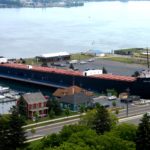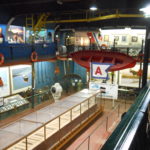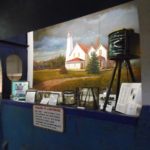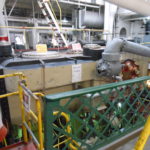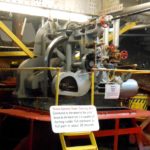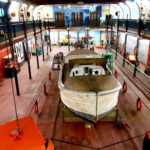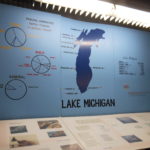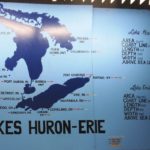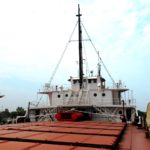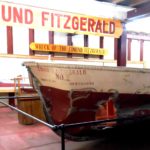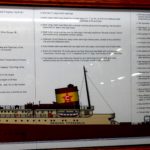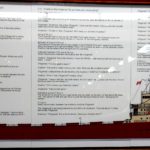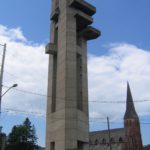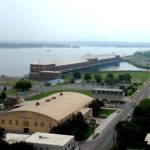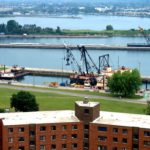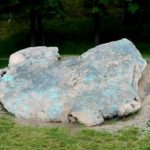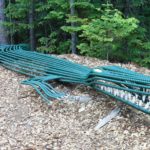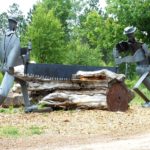We visited Marquette in 2010, near the western end of Michigan’s Upper Peninsula, which is like a “roof” over the state. We loved the city and conveyed many stories of its beauty and history in our e-book, The Journey. And we heard so much about the UP that we vowed to visit more of it, especially the eastern end.
This was our chance. Heading north again on Rte. 75 across the Mackinac Bridge dropped us in St. Ignace, and another 50 miles put us in Sault Ste. Marie – as far as you can go without crossing the Canadian border. (Incidentally, the other end of Rte. 75 is just north of Miami!)
Sault Ste. Marie translates to “Rapids of St. Mary.” They bridge the gap between Lake Superior and Lake Huron. The “Soo” Locks first tamed the rapids in 1855. Today, there are four locks available for ships of all sizes maintained by the U.S. Amy Corp of Engineers: Poe (1896; rebuilt 1968), Davis (1914), Sabin (1919) and MacArthur (1943). Davis and Sabin are supposed to be replaced by a super lock; while ground has been broken, the funding is still not appropriated. There is also a small lock on the Canadian side, opened in 1998, that is used primarily by pleasure craft. Fun facts: the locks handle over 90 million tons of cargo on 11,000 ship passages annually. A single 1000 foot “Laker” carries the cargo of 60 – 100 train cars or 2,300 large trucks. The neighboring hydroelectric plant produces over 150 million kwh of electricity each year.
We had lunch at the appropriately named Lockview Restaurant, and we watched a huge Coast Guard buoy tender maneuver itself into the nearest lock. As we sat there finishing up our sandwiches, it began to disappear. We chomped quickly and ran across the street to view the sinking as the water flowed out and lowered it to the outbound level. Regrettably, I had neither camera nor cell phone!
Sault Ste. Marie also provided an opportunity to explore one of the mighty ore ships stem to stern. The MV Valley Camp (1917) is berthed on the waterfront as a museum representing the fleet that plies the waters of the lakes to this day. Inside its vast cargo hold and around its decks are numerous exhibits revealing the challenge to take these behemoths to sea. One can wander from stem to stern. If you visit the wheelhouse and look aft, the fantail seems to be in the next county. An informative exhibit is a series of simple charts that show each lake, its position in the chain and the commercial shipping value it brings. Please enjoy the gallery below that pictures many features of this self-guided tour.
On one level of the poop deck is a memorial dedicated to the Edmund Fitzgerald, whose loss with all hands in 1972 is retained for posterity by Gordon Lightfoot’s mournful ballad. The complete lyrics are part of the exhibit. More poignant, however, is the battered lifeboat that may have given brief hope to some of the crew. As a lifelong sailor, I am reminded, with tears in my eyes, of the Navy Hymn: Eternal Father, strong to save / Whose arm hath bound the restless wave / Who bidd’st the mighty ocean deep / Its own appointed limits keep / Oh, hear us when we cry to Thee / For those in peril on the sea.
- The lifeboat
- Two of the
- …three panel chronology.
A sister exhibit to the MV Valley Camp is the Tower of History. A 210 foot structure, it was originally built by the Catholic Church to herald the early missionaries in the area. Today, it provides historical extracts of the region’s religious and secular history. I found it even more fascinating as the source of a bird’s eye view of the entire downtown and harbor area. The results are below. It took me a long time to find out what the long building along the waterfront is: The Cloverland Cooperative Hydroelectric Plant!
- The Hydroelectric Plant.
- Harbor on the Huron side.
- City Hall
- The church next door.
- Rapids on the Canadian side.
- Downtown
After Sault Ste. Marie, we trekked westward across the UP. We did stop in Marquette again, to refresh our minds of the beautiful Lake Superior. In fact we found one new – and one renewed – attraction to visit.
Our friend Worsley in Grand Rapids declared that the largest copper nugget in the world was not to be missed. We drove back to Presque Isle Park, a venue with which we were very familiar, and found it — a slab of “glacial float” copper, discovered in the Keweenaw Peninsula in 1998 and moved to the park two months after our earlier visit. It measures 15 x 13 feet and weighs 28 tons. Float copper or drift copper is literally transported by glacial movements.
We were in town in 2010 on the very last days of the existing Marquette Regional History Center. Our return allowed us a trip through the new facility. Night vs. day — it was a major wow factor.
How we missed Lakenenland last time around, we can’t figure. It has been open since at least 2007, about 15 miles outside of Marquette. Tom Lakenen is an ironworker-turned-artist who has created a drive-through park of immense proportions. He built the 37 acre park and its 80 sculptures to “have something to do during layoffs after I stopped drinking.” Harassed by the local jurisdiction, a town called Chocolay, he continues to try to provide something for everyone. In addition to his art, he’s built perch-filled ponds for young anglers, a rest stop on a snow machine trail though his property, and a bandstand for anyone to use and enjoy. The path through his art is not a route one can take casually; it’s important to walk it or drive it twice with many stops of contemplation on the second pass. Like the Hudson car pictures in Shipsewana, I will limit my pictures below – with difficulty. My artistic readers, I hope, will demand more!
We consider ourselves even more Yoopers than ever.

